CESAP
The article below describes an experience in popular organizing: Venezuela's popular women's circles (circulos femininos populares). This model for organizing was developed by CESAP (Centro al Servicio de la Accion Popular—Popular Action Service Center). The model has its origins in a 1974 evaluation of CESAP's most significant efforts in metropolitan Caracas and also in the interior, dating back to 1965. This evaluation included an analysis and a projection of the current situation of the popular class and the country as a whole.
CESAP's mission is to aid in the construction of a just society. Concretely, it seeks to promote the human and organizational development of members of the popular class, by fostering an educational process that affirms both class consciousness and personality among the people. CESAP also seeks to develop the capacity of the people for self-organization and empowerment.
Theoretical Background
Our point of departure for the development of this model was a structural analysis of our society. We saw that we were living in an unjust social environment. We studied the historical development of Venezuelan society, considering economic, political, and cultural factors and their influence on social evolution.
We saw clearly that we are living in a society stratified by class, in which politics and culture are determined by the structures of dependent capitalism. As a result, any grassroots social action project must work for not only social and cultural change, but also a progressive change in the political economy of the community.
After characterizing the reality of injustice in our society a little more fully, we will focus in on factors that we see as impediments to the full participation of the popular class, such as:
- Downward mobility.
- Fear of change.
- Passivity and conformity.
- The search for immediate solutions that bring individual economic benefits.
- The lack of experiences of organization or any tradition of struggle through which appropriate skills and abilities could develop.
In order to act upon social reality and be truly grounded in an evaluation of approaches to grassroots work, any model for organizing must have its own conceptual base. That is, the concepts employed must derive from the work itself and its ongoing evaluation. Our conceptual approach is spelled out below.
We use the terms "popular work" and "popular action" to describe projects that help groups from slums, poor neighborhoods, or rural villages to:
- Discuss and reflect on the causes of the problems that they live with as residents of a poor urban or rural community and as members of the popular class.
- To analyze the situation of their sector and organize on its behalf a service or ongoing activity such as adult education, literacy classes, training programs for adults or youth, or income-generating projects.
Popular work must thus include an educational and an organizational aspect. The educational aspect promotes, by means of reflection and discussion, the values of solidarity, initiative, cooperation, collective work, justice, responsibility, and affirmation of the character and awareness of the people. The organizational aspect encourages grassroots groups to undertake projects or actions that respond to the needs of poor urban and rural communities.
A key role for the popular class emerges from an analysis of social reality. We have noted the necessity of promoting organizations that have concrete objectives and are participatory and self-managing in character. Grassroots groups should support everyone to participate and to share in decision-making power; the group as a whole should help each member find a role to fill.
Women in the Popular Class
Before putting our model for popular women's circles into practice, we studied the place of women in the popular class. We found that women participate the most in seeking to meet the needs of their communities. As a consequence of their social role, they are the most stable and permanent residents of poor urban and rural communities.
Women are involved in committees and associations devoted to school children, community education, and social action, as well as religious and political organizations. However, their contributions are not valued fully by either the organizations or the women themselves. Women are often denied a voice in a group's statements or actions, on the basis that they merely react to situations emotionally rather than thinking things over. Instead, they may be seen as simply adding numbers or a feminine presence to a particular action. It is also widely believed that women cannot adequately represent their neighbors.
In the face of all these firmly held beliefs, we came to conclude that poor women are doubly marginalized. Promoting greater participation by women, we saw, is a key priority—not only so that women can gain equal treatment, but also so that the entire community can be better equipped to overcome the structures that create and recreate our unjust society.
It is worth noting several crucial dimensions of the experience of poor women that can illuminate their outlook: their social role, psychology, and family role.
The social role played by women of poor communities is conditioned by the double exploitation to which they are subject: exploitation of gender and of class. Every day, women confront the task of providing for the basic needs of the rest of the family. Women are almost entirely responsible for the care and education of their children. This harsh daily reality shapes women's concerns and aspirations so that all their energy is expended in a desperate attempt to better their situation.
Psychologically, the female role imposed by society is so rigid, and other alternatives so entirely lacking, that a feeling of helplessness is created toward any tasks that depart from that traditional role. Women learn to discount their own abilities and potential, to fear failure when faced with the prospect of autonomous action. Their sense of self is diminished and their self-esteem is lowered.
In the family structure, women are central, both as mothers and as wives. These roles, especially motherhood, in turn constitute for women the center of their lives. Most of their energy, both physical and psychological, is devoted to fulfilling these roles.
The Popular Women's Circles
CESAP's Women's Program sought to respond to the situation we have described through its project of organizing popular women's circles. These groups were conceived as an instrument through which women could confront and analyze their family situation, enabling them to:
- Fully value their roles as wives and mothers.
- Come to see that they live in a community whose problems demand collective action in order to reach collective solutions.
- Come to see that women must join together as equals to share their experiences and figure out these solutions.
The CESAP project sought to form women's groups in different neighborhoods so that members could share their experiences in the family and in the community. Such groups could also promote the involvement and development of grassroots women.
The objectives of the popular women's circles were to create a forum where women could:
- Share and discuss the most immediate needs and problems of their families and the communities.
- Discover, by exploring their experiences in their own setting, how they could initiate a process of self-development that would permit them to form a critical understanding of their situation and to affirm their identity as women.
- Explore ways of working for the good of their community, either by developing new approaches or strengthening those already existing, so that the community could address its own problems.
- Suggest workable alternatives to women's most critical problems in their neighborhood or community.
- Open up space in discussions of national policy so that women could speak out about their situation as women and as part of the popular sector.
In establishing the popular women's circles, we knew that each group would both influence and be influenced by all the others. Both processes—the development of individual groups and the development of the project as a whole—would feed into each other.
We envisioned that each group, with its particular characteristics and its own level of development, would make certain contributions to the whole, deriving from its own concrete situation. At the general level, these contributions would then be systematized through a process of collective analysis, which would take place at the highest level of organizational consultation and decision-making—the annual National Congress—in light of our common goals and objectives. This synthesis would yield a general approach that would support each group in realizing its concrete plans. Then, once these plans were put into practice, each group would analyze its actions and their results, in terms of successes and failures and what was learned. These evaluations would once again form new input for the cycle of feedback and refinement.
Each local group has three levels of participation. The first circle is formed by the coordinators of the popular women's circle, who take responsibility for planning meetings, working out the details of policies decided by the second circle, and so on. The coordinators are elected by the group on the basis of their experience, availability, and participation. They receive ongoing leadership training to help them fulfill this role. Each circle has an average of four coordinators. They meet every week or two, depending on the group and its activities.
The second circle is made up of the most consistent members of the group—those who attend all or nearly all of the meetings and activities organized by the first circle. This circle is, in effect, the actual group. Together with the coordinators, the second circle discusses and evaluates all of the group's activities, considering their successes and failures, obstacles and what they have learned. On the average, twelve women (including the coordinators) make up this circle. They meet weekly or biweekly as the group's activities dictate.
All of the other women in a given community make up the third circle. They may participate in the group's activities at times, but cannot do so frequently—for example because of their jobs. The number of participants varies according to the specific activity.
Some of the most important types of activities are:
- Discussion groups on the problems of women, their families, the community, and the nation.
- Larger-scale meetings on topics that address the needs of the community for information and education.
- Courses in skills including sewing, baking, and the like.
- Ongoing projects for the establishment and maintenance of public services and community infrastructure, such as streets, sewers, water public transit, and schools and community centers.
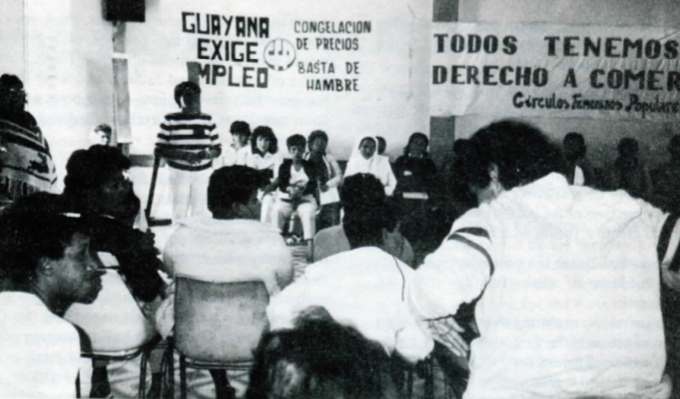
Several of the groups have organized popular kindergartens, despite the lack of resources or even a building. Meetings and educational sessions are held with the mothers of the children in the kindergartens. The mothers also provide afternoon snacks and educational materials for the children. For some of the popular women's circles, this is their ongoing community service activity.
Other groups have organized income-generating projects as their ongoing activity, with producer's cooperatives in various crafts or other products. These workshops offer women the possibility of economic benefits; their products may be sold inside the community at a low price or outside the community.
Other projects have focused on women's literacy, health, consumer groups, women's rights, and education of children.
Joint actions are also undertaken by all of the circles together. Each year a common project is proposed so that all of the groups can work in solidarity to address a larger-scale social problem. These projects are selected and planned in the annual National Congress with the participation and input of all the circles.
Stages of Development
An important element in any self-determining process is the existence of a clear line of work that expresses the objectives of the organization and can be translated into a concrete plan of action. By its own nature, a self-determining process is difficult to pin down, which in practice translates into difficulty in arriving at a common plan of action. Here the question arises of when self-determination becomes simply a lack of any long-term perspective. Must every group follow the same path, making the same mistakes, in order to find for itself an effective way of working?
Clearly it is necessary to work out an approach which, without being rigid, can guide the activities and the process of the groups. We have tried to systematize such an approach through the process of collective reflection. The elements of our approach may be grouped as follows:
- Group actions and activities: successes, failures, obstacles, and their effect on the community.
- The process of the popular women's circles as it is lived out at the individual and group levels throughout the group's existence.
In working toward a systematic approach we have sought to identify key elements that facilitate the effective achievement of the group's objectives. We looked for elements which help the group to integrate its experiences and internalize the values we wish to develop; that is, which support the harmonious development of the two key aspects of organization and education.
To develop this systematic approach, we began with evaluations carried out by the longest-established popular women's circles and by other community organizations. We also sought to establish an ongoing interchange by way of conferences and meetings with these circles and organizations.
We identified three stages of organizational development, which are detailed below.
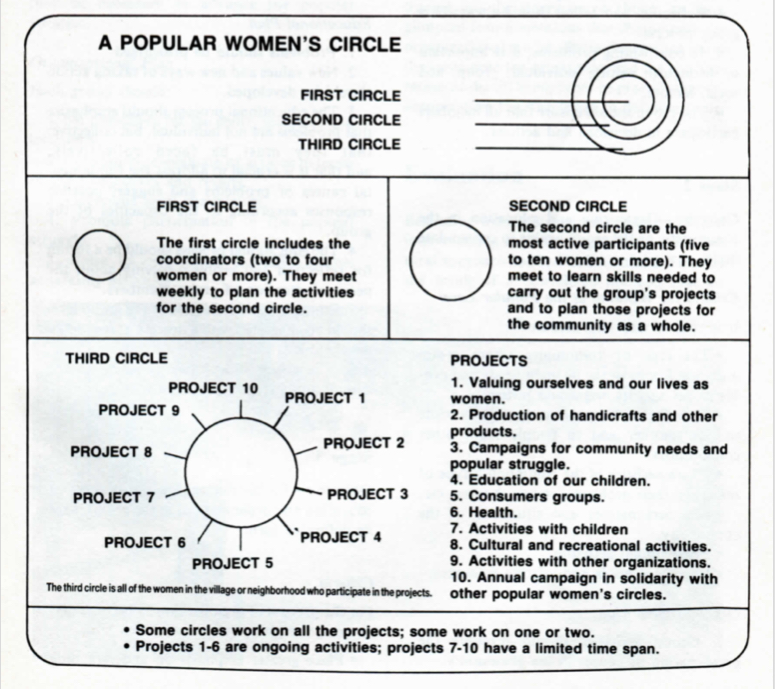
Stage 1
Objective—Formation and organization of a group.
Criteria
- To foster the participation of other people in the community.
- To start from the people: how they live, their setting.
- Establish relationships with other groups.
- Respect the people and help them identify their problems.
- Emphasize initial activities.
- Identify and develop potential coordinators to ensure continuity.
Organizational Plan
- Start the group off with activities that help people know each other better so that they can develop a stronger basis of trust and friendship.
- Every group must undergo change and crisis in order to better define its objectives.
- All plans should be made together and everyone in the group should take some responsibility.
Educational Plan
- The group should address the situation that its members live in.
- The group should check out its members' satisfactions and frustrations.
- It is important to share family concerns and people's problems and aspirations.
- Reflection and action should always be a group process.
- In confronting problems, it is important to distinguish among individual, group, and social factors.
- The group should ensure that all members participate in decisions and actions.
Stage 2
Objective—Organizing and education in the community, as the group begins to consolidate itself.
Criteria for Working at the Popular Level
It is vital to take into account:
- The type of community where group members live or work: its main needs and problems, its age, its origin and history.
- How do people from that community relate to one another and to people from other communities?
- Characteristics of the community: type of residents; their problems; streets, houses, etc.
- Key personalities and situations of the community.
- Predominant activities.
- Important needs and existing resources.•
Organizational Plan
- Group activities should promote the participation of people in the community.
- Various types of meetings and activities should be organized.
- Coordinators should be trained who can take responsibility for leading the group.
- Every group should be open to new members and to cooperation with other groups.
- Each group should seek to win the recognition of the community.
- Community work should achieve concrete results.
- Each group should establish an ongoing relationship with its community through meetings, assemblies, home visits, newsletters, and so on.
- The plan should help the group respond to the real needs of the community.
Educational Plan
- Problems should be prioritized.
- New values and new ways of taking action should be developed.
- The educational process should emphasize that problems are not individual, but collective; that they must be faced collectively; and that it is crucial to address the fundamental causes of problems and suggest possible responses according to the capacities of the group.
- The educational process should be a forum for reflection and problem-solving about the personal situation of group members.
- Education and reflection at the group level should be integrated with a process of individual development.
- The group should pay attention to the community's response to its efforts.
Stage 3
Objective—To institutionalize the process of education and organization, as the group takes its definitive form.
Criteria
For the process of organization to become permanent, the group must:
- Place greater emphasis on understanding and struggling against the obstacles it faces in a given setting.
- Recognize those people who try to work responsibly.
- Constantly evaluate whether it is moving toward real permanence of organization and action.
For the educational process to become permanent, the group must:
- Act in such a way that its work is legitimized within the community.
- Promote the orientation of taking joint action to solve common problems.
- Increase the general level of awareness in the community.
- Promote solidarity and mobilizations that may be necessary to advance the popular struggle.
Organizational Plan
Each group should:
- Set objectives for the short, medium, and long term.
- Constantly re-evaluate its actions in terms of their objectives and results.
- Overcome local chauvinism.
- Promote participation in the popular struggle.
- Raise its own funds through income-generating activities.
- Form an ongoing core group for popular action
Educational Plan
Each group should provide a space for members to:
- Continuously reflect on their lives, experiences, and group actions.
- Affirm and develop their personalities.
- Establish a group identity with its own approach and class consciousness.
- Develop a socialist vision and attitude toward life.
In articulating a systematic approach to the process of organizational development and in tracing out the stages noted above, we have glimpsed four dimensions that characterize the organizational model. These dimensions are at the same time the orientation and the configuration of the different types of practice that the organization has developed in defining itself.
Evaluation
Beginning from a structural analysis and then implementing in concrete practice a nonstructural approach has had its limitations. This was the result of a considered decision that we should use a nondeterminist methodology that would counterbalance the theoretical nature of the analysis and would serve as an adequate vehicle for self-managing groups. However, in the course of implementing our model, situations arose that indicated that this decision constituted a theoretical leap that left hanging the preliminary analysis of the unjust situation. What was lacking was an analysis of the current situation in terms of the social forces acting in the political, economic, and social arena, and their global expression. This lack of analysis we have termed a theoretical problem; other lacks, deriving from the absence of methodological structure, we have termed methodological problems.
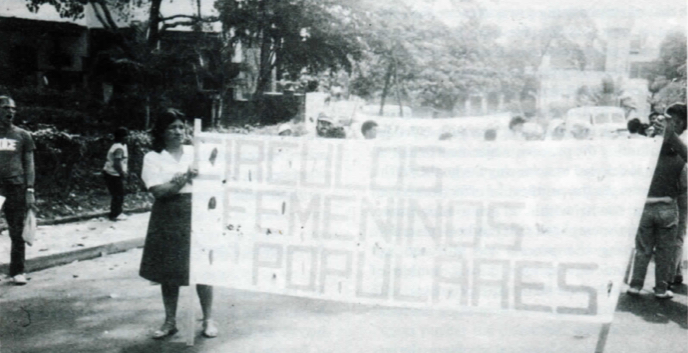
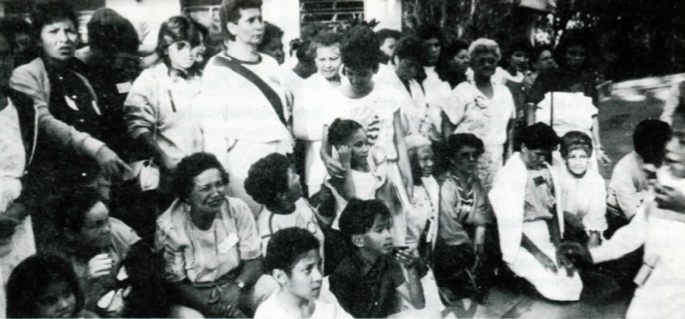
The first of these methodological problems is that of emphasizing a process over the effectiveness of its results. We have looked to the process as an expression of the level of development reached by group members, hoping that this process would be self-directed toward goals determined by the group itself. The danger of this approach is that a lot of energy is expended in facilitating the process, while insufficient attention is devoted to achieving the goals. At this point emerges the problem of effectiveness, of reaching results within a given time-frame. Likewise, the emphasis that has been placed on systematizing the process has diffused our analysis and our actions into a jumble of possibilities that are difficult to prioritize, with the consequent danger of diminishing the focus of the work even further.
A second methodological problem derives from the tension between valuing one's own experience and validating both theoretical understanding and the experiences of others. In seeking to establish lived experience and its teachings as a constant reference point, our approach has made it more difficult for groups to value and to use theory, as well as the experiences of other organizations. In consequence each group tries to start from scratch, ignoring what could be learned from the history of other organizations; much effort is thus expended in accumulating experiences and constructing traditions.
There is also a tendency to overvalue activism and the concrete, disdaining ideological and theoretical reflection on principle as unnecessary and always partial or contingent. A related phenomenon is burnout among people with more time in the organization who have already traveled some distance and been through a process, and thus have achieved a broader and more effective perspective on the group's actions and plans. Such people are subject to a kind of paralysis—because they must wait for new members to go through the same process and discover for themselves what is already obvious to those with more experience.
Successes: Practice as "Regulator"
We have found that the organizing process that began more than twelve years ago has an inherent ad hoc impulse.
By continuing to work with groups from the popular class, nourishing their identity with reflection and analysis of their needs and aspirations as a class, we have been able to consolidate that identity as a permanent reference point. By establishing an ongoing activism that can confront the injustice of our situation, framing goals that extend over a broader and broader social reach, we have assured the permanence and dynamism of the organization. Currently we are operating in fifteen states of the country.
Our commitment to identity, to working systematically, to analyzing and evaluating the social effects of our intervention, have all assured the harmonious development of the organization and have moved it forward as a whole, without splitting or turning aside from its path.
Some type of internal regulating system has proved necessary so that the process can sustain itself in the face of objective and functional requirements that are diverse and sometimes vague. The concrete experiences of the groups has served as this system. The experiences of the older and newer groups alike have determined the practice of decision-making on plans and goals.
Difficulties
As the organization has continued to develop, we have come to see a certain tension between whether to emphasize the expansion or the consolidation of our existing organizational structures. Should we keep expanding the organization at the same rate as previously? Or should we devote more of our resources to consolidating the level of training and organizational development and the funding base of the existing groups?
Each year, during our annual priority-setting process, we discuss where to put more emphasis: in the qualitative aspect—that is, consolidation; or the quantitative—expansion. Obviously, this is not a problem that can ever be solved once and for all. Instead, we have tried to set criteria that allow us to maintain a productive tension between the two.
Another difficulty arises in trying to clarify the ideological impact of our efforts. If only transformations of consciousness could be measured, it would be far simpler to address this question! We do, however, see that such transformations are taking place—for example, when members of a group analyze a given problem in terms of socio-economic structures instead of personal or cultural lacks. Another evidence of such transformation is when the solutions that are suggested are collective solutions that speak to the full extent of the problem, and not merely individual or local answers. Likewise, we see development when the whole person is taken into account in responding to individual or group problems. People are seen not just as collections of needs and problems, but as organic beings with feelings, a self-image, a family network, and so on.
A final difficulty is the blocks we face in trying to discuss political questions. Our cultural and ideological milieu works to discount any critical awareness. Culturally, any language that sounds "leftist" or questions the status quo is repressed and disparaged. This is a result of the ideology that holds a quiet and subtle hegemony in our environment. Thus it becomes far more difficult for our organization to speak out and question what is going on in Venezuela. Likewise, the situation demands that we find a new language to express our views, something which is difficult to create.
The Oldest Groups
There are several groups that broke trail for the organization, pioneering without any guidelines or models for preparation or evaluation. Today it is important to maintain and nourish their efforts. The objectives and internal structure they established for themselves, their channels of coordination and their guidelines, are the very basis of our organization.
Within these groups are some people who have fully internalized the organizational process, while others have merely been through it. Membership has fallen off in some of the oldest groups, and new members have not been incorporated, so that the groups remain arrested in a certain stage of their development. The process of personal and organizational development pushes the oldest individuals and groups to represent the organization's values and experiences, which has caused conflicts and even crises. Often the organization is rigid in demanding too much from its oldest members. Other times the reverse occurs: the oldest members are rigid and demanding with the organization. A balance between these extremes is maintained by our commitment both to the living process of the groups and to its theoretical and practical effects.
Being a Women-Only Organization
Our organization is composed entirely of women. This social composition is the most basic foundation of our identity. In repeated discussions and confrontations with other groups devoted to popular action, we have argued for the role of a popular women's organization. At the broadest level of our movement, there is an organizational vacuum for women of the popular class. There are no concrete instances in which women's participation has gone beyond short-term demands and ways of organizing that reinforce women's traditional roles. Our organization thus fills a vital and indispensable function.
Each time a new one of the popular women's circles is formed, and especially with groups whose efforts are less concrete, the same debate re-emerges: should the group continue with women only or should it reconstitute itself as a mixed group? So far, we have continued to maintain a sense of the difference between ourselves as a popular women's organization and a mixed popular organization—and to see value in maintaining that difference. We see our role as promoting the participation of women in the problems of the popular class as a whole. As an organization, we also work for women's rights—so that women can speak for ourselves and take our rightful place in the struggle.
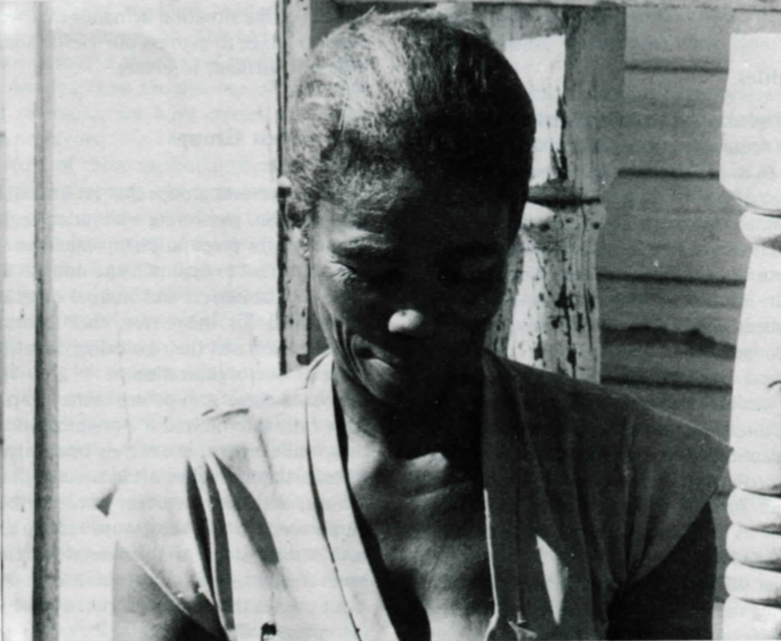
Equipo de los Circulos Femininos Populares
Programa de Unidades de Produccion
CESAP
Apartado 4240 Caracas 1010-A
Venezuela

